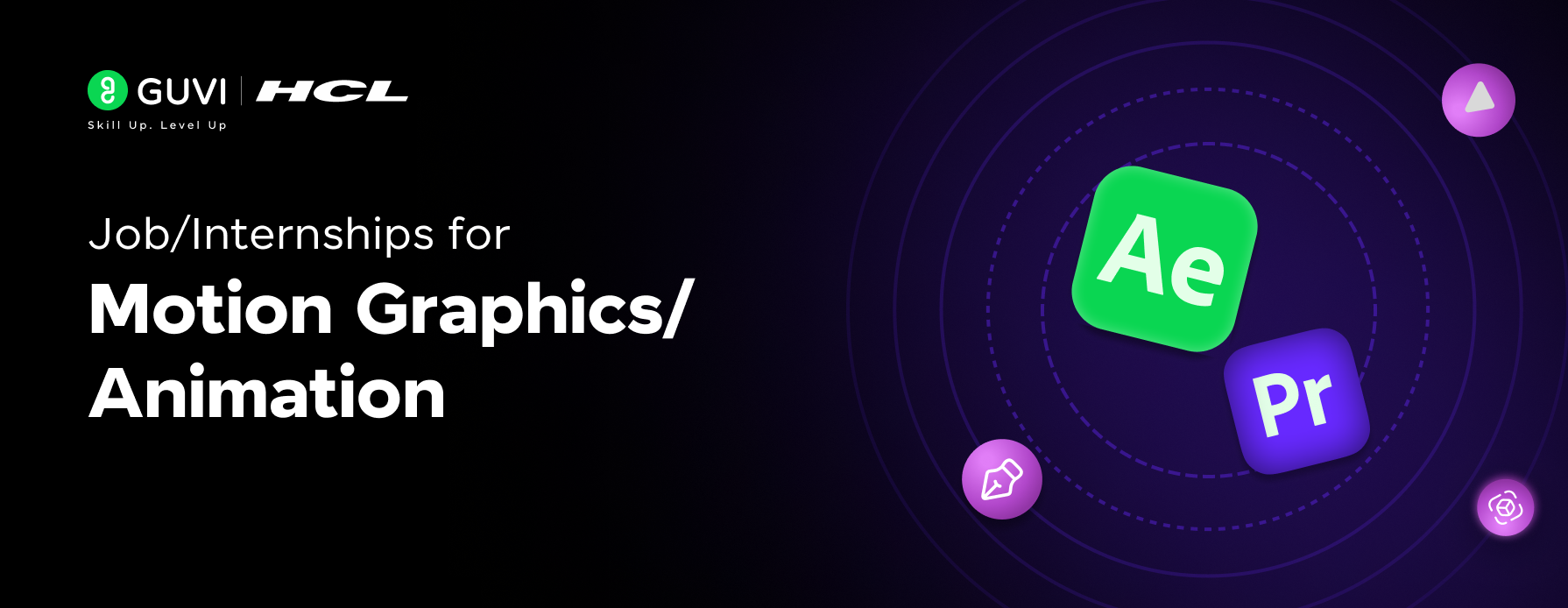
Top 10 Jobs/Internships for Motion Graphics Animation: How to Get Ahead in the Industry
Mar 29, 2025 6 Min Read 1856 Views
(Last Updated)
When you think of motion graphics and animation, visions of vivid animations, stunning VFX, and dynamic text animations come to mind. These creative roles are no longer confined to entertainment—they drive engagement in everything from social media to UX design.
Motion graphics and animation are the heartbeats of today’s digital storytelling, and they’re more in demand than ever. The global animation industry is expected to reach $587 billion by 2030, with job opportunities proliferating across entertainment, advertising, and even tech.
If you’re passionate about blending creativity with cutting-edge tools, this field offers countless avenues to explore. The opportunities are vast, from Motion Graphics Designers crafting animations for commercials to VFX Artists creating stunning effects for movies. In this blog, I’ll guide you through 10 exciting Jobs/Internships for Motion Graphics & Animation, sharing the skills you need and where to start, so you can carve out your path in this booming industry.
Table of contents
- How Motion Graphics and Animation Help Businesses Thrive
- Top Jobs/Internships for Motion Graphics & Animation
- Wrapping up- Jobs/Internships for Motion Graphics
- FAQs
- What qualifications do I need to become a Motion Graphics Designer?
- How important is a portfolio for landing internships or jobs in motion graphics?
- What industries hire motion graphic designers?
How Motion Graphics and Animation Help Businesses Thrive
Motion graphics and animation are transforming how businesses communicate with their audiences. It’s a highly effective way to capture attention and convey complex messages quickly. Studies show that animated content boosts engagement and conversion rates—64% of consumers are more likely to buy after watching a video. Motion graphics also allow businesses to differentiate themselves in a crowded market, helping to create memorable branding and convey stories that emotionally connect with audiences across multiple platforms.
Key reasons why businesses benefit from motion graphics include:
- Engagement: Motion graphics instantly grab attention, making it easier to hold viewers’ focus in today’s fast-paced digital world.
- Simplified Communication: Complex ideas or processes are simplified into digestible, visual formats, making the message clearer and easier to understand.
- Boosted Conversions: Videos with motion graphics often result in higher conversions and increased brand perception, driving customer loyalty and purchases.
- Brand Recognition: Animated logos and visual storytelling elevate brand identity, making the brand more memorable across social media, websites, and advertising.
Top Jobs/Internships for Motion Graphics & Animation
Motion graphics and animation offer a wide array of career opportunities. Each role requires a mix of creativity, technical expertise, and the ability to bring static visuals to life. Let’s dive into some of the most exciting job profiles, starting with Motion Graphics Designer.
- Motion Graphics Designer
As a Motion Graphics Designer, you’re the creative force behind animated visuals that bring static designs to life. Whether it’s an eye-catching ad or a dynamic explainer video, your work helps brands tell their stories in a way that captures attention. You’ll take ideas from concept to completion, working closely with teams like video editors and marketers. This role is perfect for someone who loves turning ideas into moving visuals that leave a lasting impact.
Tools You’ll Use: After Effects, Cinema 4D, Blender, Adobe Illustrator.
Key Responsibilities:
- Creating and animating visuals for video content, social media, and ads.
- Collaborating with video editors, designers, and marketing teams to create cohesive projects.
- Keeping up with the latest trends and techniques in motion design.
Key Concepts You Need to Master:
- Animation Principles: Perfect timing, movement, and transitions.
- Storyboarding: Planning your animations to ensure smooth workflows.
- Visual Storytelling: Using animation to communicate messages effectively.
Average Salary: ₹4 LPA to ₹12 LPA depending on experience and industry.
We have curated a list of the top 5 best motion graphic courses available for beginners, if you are keen to break into the industry, check out our blog “5 best motion graphic courses available online.”.

- 2D/3D Animator
A 2D/3D Animator specializes in bringing characters and environments to life, creating immersive worlds for films, video games, or advertisements. Whether you’re animating hand-drawn 2D visuals or building 3D models, your work engages and captivates audiences. You’ll collaborate with directors, designers, and story teams to ensure your animations fit seamlessly into the overall narrative, making every movement feel fluid and purposeful.
Tools You’ll Use: Maya, Blender, Adobe Animate, Toon Boom Harmony.
Key Responsibilities:
- Animating characters, objects, and environments for media projects.
- Collaborating with story teams to ensure smooth visual storytelling.
- Rigging models and perfecting movement dynamics.
Key Concepts You Need to Master:
- Character Animation: Bringing personality and fluidity to movements.
- Rigging: Preparing 3D models for animation.
- Timing and Spacing: Ensuring the animation feels natural and engaging.
Average Salary: ₹5 LPA to ₹15 LPA depending on experience and industry.
- Video Editor with Motion Graphics Expertise
A Video Editor with Motion Graphics Expertise merges video footage with dynamic animations, creating content that stands out. You’ll handle everything from cutting raw footage to adding animated elements like text, icons, or effects that enhance the final product. Working with creative and marketing teams, your job is to make videos that engage, inform, and entertain audiences.
Tools You’ll Use: Premiere Pro, After Effects, DaVinci Resolve, Final Cut Pro.
Key Responsibilities:
- Editing video footage and incorporating motion graphics.
- Collaborating with teams to ensure the final product aligns with project goals.
- Adding text animations, lower thirds, and visual effects to videos.
Key Concepts You Need to Master:
- Video Editing: Cutting and assembling footage to create a cohesive narrative.
- Motion Graphics Integration: Blending animation seamlessly with live-action footage.
- Post-Production Workflow: Managing timelines and multiple assets efficiently.
Average Salary: ₹4.5 LPA to ₹12 LPA depending on expertise and projects.
- Visual Effects (VFX) Artist
A VFX Artist creates jaw-dropping special effects that enhance the realism or fantasy of live-action footage. From explosions to magical landscapes, your work brings imagination to life. You’ll work on feature films, advertisements, or TV shows, collaborating closely with directors and editors to ensure every effect looks seamless.
Tools You’ll Use: Nuke, Houdini, After Effects, Maya.
Key Responsibilities:
- Creating and integrating visual effects into live-action footage.
- Collaborating with directors to ensure effects match the creative vision.
- Using simulations and compositing techniques for realistic effects.
Key Concepts You Need to Master:
- Compositing: Combining multiple layers of images and effects.
- Simulations: Creating realistic natural effects like fire, water, or smoke.
- Green Screen Removal: Seamlessly integrating effects into scenes with chroma keying.
Average Salary: ₹6 LPA to ₹18 LPA.
To enhance your skillset in motion graphics and animation, it’s vital to stay updated with industry advancements. One such opportunity is GUVI’s Adobe Certified VFX Course with AI Integration, which combines traditional VFX techniques with AI-powered tools, helping you master cutting-edge technologies. Affiliated with Adobe, this program equips you with the skills needed to stay competitive in a rapidly evolving creative landscape.
- UI/UX Motion Designer
A UI/UX Motion Designer creates interactive animations that improve user experience in digital products like apps or websites. Your goal is to make interactions smoother and more engaging by adding motion to buttons, menus, and transitions. Working with designers and developers, you’ll ensure that these animations not only look great but also enhance the user journey.
Tools You’ll Use: Figma, After Effects, Principle, Adobe XD.
Key Responsibilities:
- Designing animations for user interfaces to enhance UX.
- Collaborating with UX designers and developers to implement motion elements.
- Testing and iterating on animations based on user feedback.
Key Concepts You Need to Master:
- Micro-Interactions: Subtle animations that improve usability.
- User-Centered Design: Aligning animations with user needs.
- Smooth Transitions: Ensuring seamless movement between screens.
Average Salary: ₹5 LPA to ₹13 LPA.
- Interactive Motion Graphics Designer
An Interactive Motion Graphics Designer specializes in creating animations that respond to user actions, enhancing interactivity in websites, apps, or digital installations. You’ll work on designs that engage users by reacting to clicks, scrolls, or other inputs, creating a highly interactive experience that captivates.
Tools You’ll Use: Adobe Animate, Unity, Blender, Cinema 4D.
Key Responsibilities:
- Creating interactive animations for digital platforms.
- Collaborating with developers to integrate animations into apps or websites.
- Designing engaging visuals that respond to user inputs.
Key Concepts You Need to Master:
- Interactive Design: Making animations react to user behavior.
- Real-Time Rendering: Creating visuals that update in real-time.
- User Engagement: Using motion to captivate and retain attention.
Average Salary: ₹6 LPA to ₹15 LPA.
- Motion Graphics Producer
A Motion Graphics Producer oversees the creative and logistical aspects of motion graphics projects. You’ll be in charge of managing teams of animators, designers, and editors, ensuring that projects are completed on time and within budget. Your role will require a mix of creativity and project management, as you guide the overall vision while keeping the production on track.
Tools You’ll Use: After Effects, Premiere Pro, Cinema 4D.
Key Responsibilities:
- Managing motion graphics projects from concept to execution.
- Collaborating with designers and editors to ensure creative alignment.
- Overseeing timelines, budgets, and project deliverables.
Key Concepts You Need to Master:
- Project Management: Keeping teams on track and ensuring deadlines are met.
- Creative Direction: Ensuring the final product aligns with the vision.
- Collaboration: Working with multiple teams to ensure smooth execution.
Average Salary: ₹8 LPA to ₹20 LPA.
- Compositing Artist
A Compositing Artist combines multiple visual elements, such as animations, VFX, and live-action footage, into a seamless final product. You’ll use advanced compositing techniques to ensure every layer fits together smoothly, often working in post-production for films, ads, or TV shows.
Tools You’ll Use: Nuke, After Effects, Photoshop.
Key Responsibilities:
- Merging live-action footage with visual effects and animations.
- Ensuring seamless transitions between different visual elements.
- Collaborating with VFX teams to create cohesive scenes.
Key Concepts You Need to Master:
- Compositing: Layering multiple elements into one seamless frame.
- Rotoscoping: Tracing motion to ensure smooth integration.
- Color Grading: Adjusting the color balance to match visual elements.
Average Salary: ₹5 LPA to ₹14 LPA.
- Broadcast Designer
A Broadcast Designer focuses on creating motion graphics for television and live-streaming events. You’ll design graphics like show intros, transitions, and lower thirds, ensuring they are visually appealing and aligned with the program’s branding.
Tools You’ll Use: After Effects, Cinema 4D, Vizrt.
Key Responsibilities:
- Designing motion graphics for television broadcasts and live events.
- Collaborating with producers and editors to create dynamic visuals.
- Ensuring consistency across broadcast visuals and branding.
Key Concepts You Need to Master:
- Brand Consistency: Ensuring graphics align with the show’s or channel’s branding.
- Dynamic Graphics: Creating visuals that adapt to live events.
- Live Broadcasting: Understanding how to create motion graphics for real-time content.
Average Salary: ₹6 LPA to ₹18 LPA.
- Kinetic Typography Animator
A Kinetic Typography Animator specializes in bringing text to life through motion. Whether in ads, explainer videos, or title sequences, you’ll create engaging animated text that enhances the message being delivered. Your role blends typography and animation to create visually compelling content.
Tools You’ll Use: After Effects, Adobe Animate, Motion.
Key Responsibilities:
- Animating text to enhance video content or advertisements.
- Collaborating with designers and writers to ensure messages are clear and engaging.
- Using animation techniques to create dynamic and visually appealing text.
Key Concepts You Need to Master:
- Typography Design: Understanding the aesthetics of text and how to animate it.
- Timing and Pacing: Ensuring the text’s motion aligns with the message delivery.
- Visual Hierarchy: Organizing text elements in a way that guides viewers’ attention.
Average Salary: ₹4 LPA to ₹10 LPA.
How to Break Into the Motion Graphics and Animation Industry
Breaking into the industry is a journey, not a sprint. Whether through formal education or self-taught skills, your portfolio, persistence, and willingness to adapt will be your biggest assets as you make your mark in this dynamic field.
It starts with building a strong portfolio. Focus on showcasing your best work, emphasizing variety and creativity. Your portfolio is the first thing employers look at, so make sure it reflects your unique style and technical skills.
Read our curated piece: What are the top skills to become an animator?
Mastering essential software tools like After Effects, Cinema 4D, and Blender is crucial. Many online tutorials and courses can help you gain expertise, and continuously practicing these skills will keep you competitive in the field.
Finally, leverage internships and networking. Whether through LinkedIn, industry events, or freelance work, making connections in the industry can lead to valuable opportunities and real-world experience. Keep learning, stay flexible, and pursue every opportunity that comes your way.
Wrapping up – Jobs/Internships for Motion Graphics
Picking a career journey in motion graphics and animation is an exciting journey filled with creative potential. As you explore internships, build your portfolio, and master essential tools, you’ll start to distinguish between the various job profiles mentioned in this blog. Each role offers a unique path—whether you’re drawn to character animation, motion graphics for UI/UX, or VFX artistry—and the key is finding the niche that aligns with your passion and skills.
As you progress, you’ll naturally refine your focus, discovering which roles resonate with your creative style. By embracing every learning opportunity, you’ll be well on your way to making an informed decision about the niche that suits you best. Stay persistent, stay curious, and keep pushing your creative boundaries—the right opportunity is out there, waiting for you to take it.
FAQs
While many motion graphics designers hold a degree in animation, multimedia design, or graphic design, the most important factor is your portfolio. Employers want to see what you can create, so building a strong portfolio showcasing your animation and motion design skills is crucial. Self-taught designers and those with online certifications can also succeed if they can demonstrate proficiency with tools like After Effects, Cinema 4D, and Blender.
A portfolio is essential for breaking into motion graphics and animation. Employers prioritize seeing your work in action over any qualifications. Focus on creating a diverse portfolio that showcases your ability to work across different styles and platforms. Include both professional work and personal projects to highlight your creativity, technical skills, and unique style.
Motion graphic designers are in demand across a wide range of industries. Common sectors include advertising, film and television, gaming, tech companies for app design, and digital marketing agencies. There are also growing opportunities in e-learning, VR/AR, and freelancing, offering flexibility and the chance to work on diverse projects.



























![Top 10 Mistakes to Avoid in Your Data Science Career [2025] 8 data science](https://www.guvi.in/blog/wp-content/uploads/2023/05/Beginner-mistakes-in-data-science-career.webp)



Did you enjoy this article?